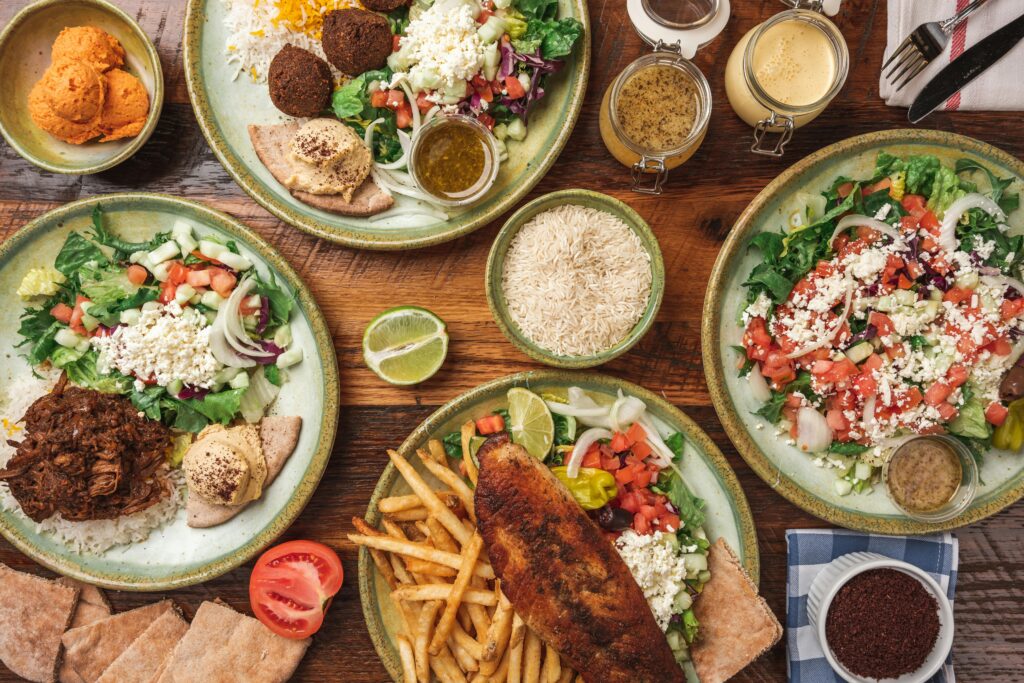Eid. The Arabic word literally means feast, festival. The name itself tells you everything you need to know. It is a period of reflection, charity, and, of course, indulgence in delicious traditional foods. Food takes center stage around the globe: Biryanis, Khoresh-e Fesenjoon (Persian Chicken Stew With Pomegranate), Aloo Palak (Spicy Spinach and Potatoes, Singapore), Chicken Yassa with Fonio (West Africa), Fatima’s fingers (Tunisian Egg Rolls), Hilib Sambuus (Fried Beef Dumplings, Somalia) Lamb Haneeth (Yemen), Maamoul (Lebanon), Bakalava (claimed by Turkey, Greece, and the Middle East) and endless cups upon cups of tea. It is a significant celebration of abundance after a month of intentional restraint. For 1/8 of the world’s population, the Muslim faithful, it is a significant celebration marking a time of joy, gratitude, and communal gatherings ending the month of Ramadan, a yearly observance of discipline, self-reflection, and intermittent fasting.
The shift from fasting to eating can be abrupt – physically, mentally, and emotionally. Here’s how to approach Eid—and more importantly, the day and life after—through the lens of sustainable, behavior-based change. By applying the principles of Behavior Nutrition, which focuses on understanding the psychological, social, and environmental aspects of food choices, one can celebrate Eid and life thereafter in a way that aligns with both tradition and well-being.
The First Myth Debunked About Eid
The task of weight loss and healthy living isn’t Eid itself, or for that matter Christmas, Easter, Utsava, birthdays, weddings, dinner parties, or any other holiday. Weight gain over any holiday season doesn’t come from one feast. That feast is a moment in time, a treasured part of our year and life. The real challenge is how we respond to the “after”, the everyday decisions that follow the celebration.
The danger is in the leftover foods, the trays of the baked goods left out in the office and at home in the days before and after the holidays. The secret and the strategy to getting through these events in your life is to “Box In” special meals on the holiday itself, or the evening before, rather than eat randomly whatever you see, whenever you see it, however you feel, throughout the season and year.
“Box In” “Box Out” Defined
To “Box In” a food means you include it in your diet. The goal is always to keep as many favorite foods as possible in your life as well as keep wearing your favorite size.
To “Box It Out” means you exclude a food or type of food (such as bite-size snacks that are easy to pop into your mouth for you to eat). For some people certain foods create such powerful cravings that they need to be treated separately. Although that may sound difficult, the majority of my clients have told me that, among all the skills they’ve developed for managing their weight, Box It Out is the single most effective, easy-to-use way to maintain success at weight control. Together, Box In and Box It Out provide a set of tools that can free you forever from overeating your problem foods – and still let you enjoy them without gaining weight.
Let’s take one of your favorites – Maamoul. You love every bite of it! It’s the fig filling that really makes your knees weak and your toes curl. With the Box In strategy, you can keep this favorite food on this special day, and you can eat as much of it as you want…on the condition that this treat won’t be on your grocery list or appearing ever in your day-to-day life in the coming months. This knowledge allows you to give yourself freedom for a delicious, special indulgence.
Here is one technique to guide you:
- If you can have “just a slice” when it is served to you, but you would overeat it if you were in your home, then only eat it when you are a guest in someone else’s home or only in restaurants. Limit those occasions to special events or hold yourself to eating it in specified restaurants.

There may be a few foods for some of us that are not a good choice for boxing it in. They ignite such strong desires that they activate my F-Q principle – first you have a little, then the frequency increases, and eventually, invariably, an increase of quantity follows. These foods trigger ongoing cravings and obsessive thoughts and lead you into a process that tears down your motivation to stay in charge. It’s the pattern that you must break if you’re going to be a lifelong winner at weight control.
As you consider your problem foods, you may conclude that it might be easier to Box Out one or two foods from your life. This is a crucial choice, one which your success hinges. When you think historically and ask the question: “Does it satisfy or does it stimulate?” and if you have a long history of abuse with a certain food, one in which every time you’ve gone back to it, it’s created powerful cravings and obsessive thoughts and your weight has retuned, then the key to control is realizing that the risk of eating it is not worth the momentary pleasure it may give you. The old adage remains true. A moment on the lips…forev…a long time on the hips.
The Day After Eid Is Where It Begins
What you do the day after Eid matters more than what you ate on Eid. The same is true for any celebration, weekend, or holiday. These moments don’t derail us. It’s how we interpret them that matters.
So, give yourself permission to enjoy Eid and any holiday fully. The next day, return to the habits that reflect how you want to feel long-term – energized, confident, grounded, and in control. In our reflection of all aspects of life, we can include our habits, patterns and practices with food. We must take a good look – clear, honest, and transparent at how, where, when, and what drives our eating. Our lifelong success at weight control depends on how well we handle the foods that tempt us the most. Part of maturing in our engagement with food is recognizing that, similar to life, we can’t have everything we want. We recognize the need to set priorities and be selective, recognizing foods and temptations that are ubiquitous, constantly encountered or not. With strategy, we can enjoy our favorite foods without putting on pounds, enjoy the power of selectivity, and live in peace with ourselves as well as enjoy the personal happiness that comes from living out the vision that we have for our lives and those we love and let there always be bread and salt between us.
خُبزٌ وَمِلح
Bread and salt
A symbol of the friendship, loyalty and bond created through shared experiences.
